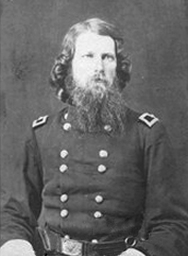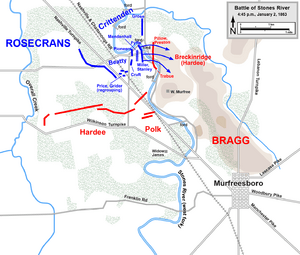James St. Clair Morton facts for kids
Quick facts for kids
James St. Clair Morton
|
|
|---|---|

Brig. Gen. James St. Clair Morton
|
|
| Born | September 24, 1829 Philadelphia, Pennsylvania |
| Died | June 17, 1864 (aged 34) Petersburg, Virginia † |
| Place of burial |
Laurel Hill Cemetery, Philadelphia, Pennsylvania
|
| Allegiance | United States of America Union |
| Service/ |
United States Army Union Army |
| Years of service | 1851–1864 |
| Rank | |
| Commands held | Chief Engineer, Army of the Ohio
Pioneer Brigade, Army of the Cumberland Chief Engineer, IX Corps |
| Battles/wars | American Civil War |
James St. Clair Morton (born September 24, 1829 – died June 17, 1864) was an American soldier, engineer, and writer. He served as a general in the Union Army during the American Civil War. He mostly fought in the Western Theater, which was the area west of the Appalachian Mountains.
Contents
Early Life and Military Training
James St. Clair Morton was born in Philadelphia, Pennsylvania. He was the oldest of eight children. When he was 14, he started studying at the University of Pennsylvania. At 18, he joined the United States Military Academy (West Point). He graduated in 1851, ranking second in his class.
Becoming an Engineer
After West Point, Morton joined the Corps of Engineers. This group designs and builds military structures. From 1851 to 1852, he helped build forts around Charleston, South Carolina, including Fort Sumter. He then worked at Fort Delaware until 1855. After that, he returned to West Point to teach math and military engineering for two years. In 1854, he was promoted to second lieutenant.
New Ideas and Important Projects
Morton was interested in new military ideas. He believed in the principles taught by Dennis Hart Mahan, a famous military theorist. Morton wrote to the Secretary of War about these ideas. He also helped evaluate plans to defend New York City. His report showed that the city's defenses needed to be improved.
After teaching, Morton became the chief engineer for the Sandy Hook Lighthouse district in New Jersey. Later, the government asked him to be the chief engineer for the Washington Monument and the water systems in Washington, D.C.. During this time, he was promoted to first lieutenant.
Exploring and Building Forts
In 1860, the Navy asked Morton to explore the Chiriquí Province in Central America. They wanted to see if a railroad could be built across the Isthmus of Panama. He found it was possible, but he got sick with malaria while there.
While recovering, Morton was sent to Dry Tortugas, Florida, in 1861. He was the supervising engineer for Fort Jefferson. His job was to get the fort ready for battle. He tried to design a fort with 420 guns. He was promoted to captain in August 1861. When he got malaria again in early 1862, he went back to Washington to recover. After he got well, he helped repair Fort Mifflin in Pennsylvania.
Civil War Service
In May 1862, Morton was assigned to the Army of the Ohio as its chief engineer. He worked under General Don Carlos Buell. He immediately started building defenses around Nashville, Tennessee. He was ordered to stay and finish these defenses while the army marched to Kentucky. These defenses, called Fort Negley, took three months to build. They became the largest inland stone fort of that time.
Leading the Pioneer Brigade
When General Buell was replaced in October 1862, Morton became the chief engineer for the Army of the Cumberland. This army was led by General William S. Rosecrans. Rosecrans needed help with engineering problems. So, he decided to create the Pioneer Brigade. This was a special unit of engineers. It had about 2,600 men, including mechanics and laborers. They trained in Nashville for a month. On November 29, 1862, Morton was made a Brigadier General of Volunteers. President Abraham Lincoln had promised him this rank.
Battle of Stones River
In late December 1862, about 1,700 men from the Pioneer Brigade joined the Army of the Cumberland. They marched to Murfreesboro, Tennessee. When they arrived, they built bridges, cleared roads, and improved river crossings. On December 31, the Pioneer Brigade was behind the Union army. Around midday, they were sent forward to support a cannon unit. They saw many soldiers running away, and the Confederate forces were getting ready to attack again.
The Pioneer Brigade was now right behind the front lines. They had a clear view of the open ground. When the Confederates attacked, Morton ordered the cannons to fire "canister" (a type of ammunition that scatters many small balls). This drove the attackers away. Morton then moved his brigade forward and held their position under enemy fire. This helped General Rosecrans gather his scattered troops and bring up new units.
The Confederates attacked three more times, finally breaking the Union front line. Morton had his brigade form up again with the cannons. As the Union front line retreated, they came out of the woods in front of Morton. The Confederates followed them. Morton ordered the cannons to fire canister again. He rode to the front and told his men, "Men, you haven't much ammunition, but give them what you have and then wade in on 'em with the bayonets!" His men stood their ground and fired, stopping the Confederate advance. Rosecrans then ordered the brigade to charge forward. The Confederates tried to attack three more times but were pushed back each time.
The next day, January 1, was quiet with only small fights. The Pioneer Brigade rested. On January 2, Confederate General John C. Breckinridge attacked the Union left side. He captured some cannons. As the Pioneer Brigade moved towards the fighting, the Confederates were already retreating. Morton's brigade helped chase them. The Confederates left the city on January 4, and the Union army won. Morton reported 12 men killed and 23 wounded in his brigade.
After the battle, Morton oversaw the building of Fortress Rosecrans until June 1863. This fort covered 200 acres and was the largest fort built during the Civil War.
Later Campaigns and Challenges
Morton and the Pioneer Brigade did not play a big role in the Tullahoma Campaign. There were some difficulties during this time. Morton was criticized for delaying General Alexander McCook's XX Corps, which got stuck behind the Pioneer Brigade.
Despite these issues, Morton was promoted to major in the Regular Army on July 3, 1863.
During the Battle of Chickamauga, the Pioneer Brigade ended up in the wrong place. They were in front of retreating Union troops. Morton had been ordered to check the front lines. He got separated from General Rosecrans and found himself with General McCook's troops. These troops were on the right side of where General James Longstreet broke through the Union lines. Morton and the Pioneer Brigade soon got caught up in the retreat.
This was a difficult time for the army. Morton was slightly wounded during the battle. He was not immediately removed from his command. However, on October 10, he was replaced by General William Farrar Smith. Morton asked to be transferred, but his request was denied. He then asked to be reduced in rank from his volunteer rank of brigadier general to his Regular Army rank of major. He left the volunteer service on November 7, 1863.
Morton returned to Nashville on November 14. He worked as the supervising engineer for building defenses there until January 30, 1864. After that, he worked as an assistant to the Chief Engineer in Washington until May.
Death in Battle
Morton returned to the battlefield in May 1864. He served as the Chief Engineer for the IX Corps under General Ambrose Burnside. On June 17, 1864, during the Second Battle of Petersburg, Morton was checking the area in front of General Orlando B. Willcox's division, which was about to attack. He was shot in the chest and died. His body was sent back to Philadelphia. He was buried with military honors at Laurel Hill Cemetery.
After his death, Morton received several special honors:
- He was recognized as a Brevet Lieutenant Colonel for his brave service at the Battle of Stones River, Tennessee (January 2, 1863).
- He was recognized as a Brevet Colonel for his good conduct at Chickamauga, Georgia (September 20, 1863).
- He was recognized as a Brevet Brigadier General for his brave service during the attack on Petersburg, Virginia (June 17, 1864).


